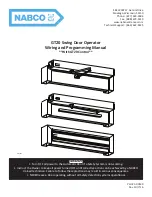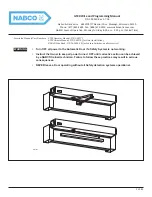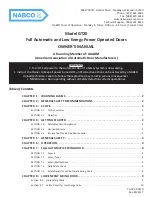
4 of 32
Opus Control Wiring and Programming Installation Manual
www.NabcoEntrances.com
P/N C-00139
Rev 10-20-17
Table 1 Wiring
Item
Description
Power Input
100VAC - 130 VAC, AC 50-60 Hz; 3A (
NABCO recommends min. 5A service)
Power for accessories
12VDC; 750mA
Output Rating
Transistor Output; 100mA @ 12VDC
Relay Output Rating
Mechanical Relay Output; 3A at 110VAC
F1 Fuse
120VAC Power Circuit of Control
Table 2 Power Draw Common Accessories
Sensor
Part Number
Current Consumption
Acuvision
V-00202
80mA
(ea.unit) at 12VDC
Optex Reaction
V-00173
125mA
Acusensor M
A-01306
150mA
Optex i-one
V-00055
130mA
Radio Control Receiver
24-11467
50mA
CX33 Logic Relay
V-00734
320mA
SECTION 4.3 Output Power Guidelines
TOTAL
current draw from the Opus Control must not exceed 0.7A when providing power to:
X
X
Sensors
X
X
Modules
X
X
Accessories
X
X
Auxiliary Equipment
If TOTAL current draw exceeds 0.7A the installer must utilize an auxiliary power supply such as the NABCO Transformer 24 VAC,
P/N A-01185.
The Opus Control must Not be used to output power to:
X
Magnetic Locks
X
Electric Strikes
To determine if an auxiliary power supply must be used, add the total current draw of all devices. Please refer to the formula below:
Example: An Automatic Door System is to be fitted with the following devices:
2 x Acusensor M @ 150 mA = 300 mA
1 x Cp/RX Radio Control Receiver @ 50 mA = 50 mA
Total = 350 mA
350mA does not exceed total current draw.
An Auxiliary Power Supply does not need to be used.
CHAPTER 5: 120 VAC GENERAL WIRING
Shut the installation site branch Circuit Breaker OFF. Failure to do so may result in serious
personal or fatal injury. When uncertain whether power supply is disconnected, always verify
using a voltmeter.
All high voltage electrical connections must be made by licensed electricians according to
National and Local electrical codes/regulations.
Permanent wiring shall be employed as required by local codes.
Electrical circuit to Nabco operator must not be not shared with other equipment such as
lighting, cash registers, or any device that might cause electrical interference on the circuit.
CAUTION
WARNING
WARNING
CAUTION
CAUTION





































